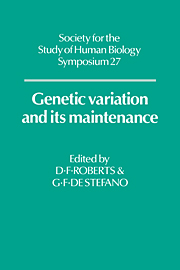Book contents
- Frontmatter
- Contents
- Preface
- Part I Genetic Diversity - Its Dimensions
- Part II Genetic Diversity - Its Origin and Maintenance
- Human genetic diversity in south-east Asia and the western Pacific
- Malaria-protective alleles in southern Africa: relict alleles of no health significance
- The genetic origin of the variability of the phenotypic expression of the Hb S gene
- Origin and maintenance of genetic variation in Black Carib populations of St. Vincent and Central America
- Historical and demographic factors and the genetic structure of an Afro-American Community of Nicaragua
- Migration and genetic polymorphisms in some Congo peoples
- Population structure studies and genetic variability in humans
- Inbreeding and the incidence of recessive disorders in the populations of Karnataka, South India
- Genetic diversity at the albumin locus
- GENETIC DIVERSITY - APPLICATIONS AND PROBLEMS OF COMPLEX CHARACTERS
- Index
Population structure studies and genetic variability in humans
Published online by Cambridge University Press: 05 March 2012
- Frontmatter
- Contents
- Preface
- Part I Genetic Diversity - Its Dimensions
- Part II Genetic Diversity - Its Origin and Maintenance
- Human genetic diversity in south-east Asia and the western Pacific
- Malaria-protective alleles in southern Africa: relict alleles of no health significance
- The genetic origin of the variability of the phenotypic expression of the Hb S gene
- Origin and maintenance of genetic variation in Black Carib populations of St. Vincent and Central America
- Historical and demographic factors and the genetic structure of an Afro-American Community of Nicaragua
- Migration and genetic polymorphisms in some Congo peoples
- Population structure studies and genetic variability in humans
- Inbreeding and the incidence of recessive disorders in the populations of Karnataka, South India
- Genetic diversity at the albumin locus
- GENETIC DIVERSITY - APPLICATIONS AND PROBLEMS OF COMPLEX CHARACTERS
- Index
Summary
INTRODUCTION
This short review of human genetic structure deals with genetic distances, display techniques, F-statistics, new types of genetic data, and genetic data other than gene frequencies (migration, isonymy, anthropometry, and pedigrees). This treatment will not be comprehensive, and there are already several other reviews, some of which are more detailed (e.g., Cannings & Cavalli-Sforza, 1973; Fix, 1979; Goodman, 1974; Gower, 1972; Harpending, 1974; Howells, 1973; Jorde, 1980, 1985; Lalouel, 1980; Leslie, 1985; Relethford & Lees, 1982; Roberts, 1975; Smith, 1977; Swedlund, 1980). In addition, applications of many of these methods are contained in the volume by Crawford and Mielke (1982). Since the mathematical equations underlying these methods are readily available in other reviews and in the original papers, most are not repeated here.
GENETIC DISTANCE
Genetic distance measures can be grouped into five broad categories: chi-squared, angular transformation, and gene substitution distances, information measures and non-parametric measures. Each of these will be discussed briefly.
The chi-squared distances include those of Sanghvi (1953), Balakrishnan and Sanghvi (1968), Morton et al (1971), Harpending and Jenkins (1973), Reynolds et al (1983), Steinberg et al (1967), and Kurczynski (1970). All of these involve the calculation of a squared difference between gene frequencies in two populations and the standardisation of this difference. These approaches are most satisfactory when the differences between gene frequencies in subpopulations are not too large (Jorde, 1985).
The angular transformation distances (Edwards, 1971; Edwards & Cavalli-Sforza, 1972) use an arcsine transformation of gene frequencies in order to make the variances of the frequencies independent of the frequency values.
- Type
- Chapter
- Information
- Genetic Variation and its Maintenance , pp. 199 - 220Publisher: Cambridge University PressPrint publication year: 1986
- 1
- Cited by



